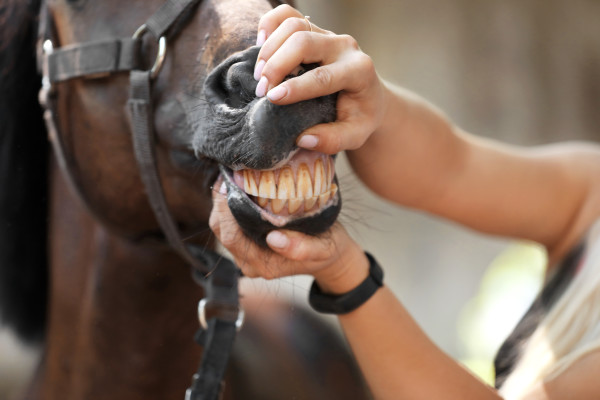Home > Horse Care > Is your horse trying to tell you his teeth hurt?
Is your horse trying to tell you his teeth hurt?
- October 7, 2025
- ⎯ Christine Barakat
Research from Finland suggests owners often overlook signs of dental pain in their horses. These include difficulty eating, bit evasions and antisocial behavior.
Researchers at the University of Helsinki surveyed the owners of 47 horses who had cheek teeth surgically removed because of tooth root infections. These infections can have a number of causes, says Jaana Pehkonen, DVM. But, in this study, she says, “most were due to dental fractures with or without predisposing dental caries.” Only six of the horses had swelling, sinus drainage or other obvious signs of tooth problems prior to their diagnosis.

Methodology
The survey respondents answered 23 questions about how their horses behaved before and after the tooth extractions were performed. For example, bit evasions (going “above” or “behind” the bit) were the under-saddle behaviors that most often disappeared after tooth extraction. Antisocial behavior toward people or other horses were the most commonly reported general behaviors that dissipated after the procedure.
Click here to read a report on the scientific study of the benefits of dental work in horses.
Behaviors observed
“In this study, bit-related behavioral problems seemed to be more common than signs related to eating and drinking in horses suffering from periapical dental pain,” says Pehkonen. “However, bit-related problems may be easier for the owner to notice because most of them probably exercise the horse more often than observe its eating behavior.”
In half of the study horses, the tooth infections were discovered during routine dental exams. This suggests that the owners did not realize the observed behaviors might indicate dental pain. Almost all of the owners—96 percent—said their horses benefitted from having the teeth removed.
What it means
“In ‘real life’ this happens a lot,” says Pehkonen. “Aggressive behavior, self-mutilation, introverted gaze are not usually regarded as indications of pain. So it is difficut or even impossible to know the horse is actually experiencing pain before [the source of discomfort] has been diagnosed and been cured.”
Based on these findings, Pehkonen recommends annual dental exams to identify problems that may otherwise go overlooked.
Reference: “Behavioral signs associated with equine periapical infection in cheek teeth,” Journal of Equine Veterinary Science, June 2019
Don’t miss out! The free weekly EQUUS newsletter delivers horse health information right to your in basket! If you’re not already receiving the EQUUS newsletter, click here to sign up. It’s *free*!





